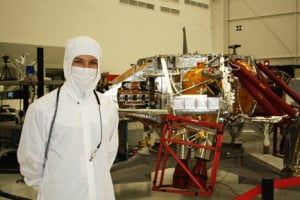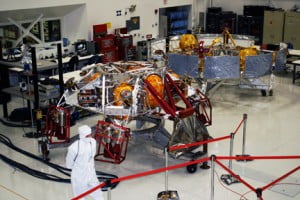By Mary O’KEEFE
Jet Propulsion Laboratory allowed reporters a rare opportunity into the Clean Room to get a close up look at the Mars Science Laboratory.
The Clean Room, or Spacecraft Assembly Facility, is where spacecraft like the Mariner and Pathfinder and now the Curiosity rover and components for the MSL are assembled. It is a clean environment where extreme precautions and procedures are followed to minimize human contamination of flight hardware.
Everyone who enters the room goes through a process of donning a full “bunny suit” which covers nearly their entire body. The room must be kept clean to protect the technical equipment that is used on the spacecrafts but also to protect the environment, Mars in the case of the MSL, from earthbound contaminants. This keeps the data recovered from the rover Curiosity purely Martian.
The MSL is in three stages in the Clean Room. There is the shell cover, the landing system and the rover itself.
The back shell is a dome-like structure that will cover the landing system and rover. A heat shield will be placed on the bottom to protect the spacecraft and the cargo it carries.
“The tiles are similar to those on the space shuttle,” said Jennifer Knight, cruise stage and aeroshell integration lead.
A parachute that is on top of the back shell deploys as the spacecraft heads down to the surface of Mars at supersonic speed.
The parachute will slow down the spacecraft, the bottom heat shield falls away and the landing system is deployed.
The landing system fires engines, moving it away from the back shell, which lands on the surface.
Unlike other Martian rovers, most recently Spirit and Opportunity that were about the size of a small golf cart, Curiosity is the size of a Volkswagen Beetle. That size caused some challenges for the engineers.
“We are given a set payload and a rough idea of what it weighs,” said Peter Illsley, rover integration lead.
The engineers are also told what type of instruments will be required. In this case the rover needed to have an arm to take samples from the surface and analyze them.
“We take those high level requirements like a sample instrument into consideration,” he added.
The project is designed and taken to a review board, which either approves or ask for other considerations.
One of the most obvious challenges was how to get a rover the size of Curiosity to the surface safely. In the past engineers had used a balloon-type landing. The rover was encased in a protective balloon that bounced along the surface of Mars. The rover then had to drive off a ramp, which was a difficult maneuver. Curiosity’s size is too large for that type of landing so the engineers came up with another solution called a sky crane.
The rover fits into the landing system. As it approaches the surface, the rover is lowered with cables onto the surface of Mars. Curiosity then cuts the cables and the launch system flies far enough away from the rover as to not to affect it when it crashes onto the surface. The rover then begins its mission of exploration.
The launch window for MSL is between Nov. 25 and Dec. 18 with an estimated arrival date on Mars in August of 2012.
For more information on the rover and all its equipment visit www.cvweekly.com or click on the QR code with a smart phone.


